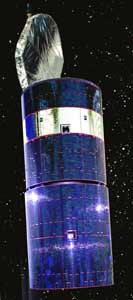Thank you very much for visiting Gunter's Space Page. I hope that this site is useful and informative for you.
If you appreciate the information provided on this site, please consider supporting my work by making a simple and secure donation via PayPal. Please help to run the website and keep everything free of charge. Thank you very much.
Astra 2D, 3A

Astra 2D [Boeing BSS]
In August 1999, Hughes Space and Communications International, now Boeing Satellite Systems, was awarded two satellite contracts from Société Européenne des Satellites (SES) of Luxembourg. The company ordered its tenth Boeing satellite, ASTRA 3A, in August 2000. The spacecraft is stationed at the orbital position of 23.5 degrees East longitude. ASTRA 3A is a Boeing BSS-376HP model.
Astra 2D, the first spin-stabilized satellite in the SES fleet, is a Boeing 376HP, for high-power, satellite. It was successfully launched on an Ariane 5 on Dec. 19, 2000. The Boeing 376 is one of the most popular spacecraft models. The delivery-in-orbit contract includes the satellite, launch services, and ground station control software for use at the control center, plus training for new satellite controllers. The Astra satellites are controlled from the SES ground station at Betzdorf in Luxembourg.
Astra 2D is the 55th 376 to be ordered from Hughes and Boeing. It will carry 18 traveling-wave tube amplifiers, 16 of which will be active. The signals will be transmitted via 39 watt traveling-wave tube amplifiers. Astra 2D will deliver digital direct-to-home television to Great Britain and Ireland. Two of the satellite's four on-board receivers will be used at any given time.
ASTRA 3A will help SES ASTRA meet growing demand for digital satellite services and will provide follow-on capacity for Deutsche Telekom's Kopernikus satellite at 23.5 degrees East. ASTRA 3A has a contracted service life of at least 10 years. The satellite provides high-power cable and direct-to-home broadband services to Germany, Austria and Switzerland. ASTRA 3A, a spin-stabilized spacecraft, operates with 20 active Ku-band transponders. The satellite was launched on 28 March 2002, aboard an Ariane-44L H10-3 rocket.
The BSS-376HP spin-stabilized spacecraft consists of two main sections. One is the spinning section, which contains the apogee kick motor, power system, primary propulsion, and most of the attitude control and command and telemetry subsystem elements. The fully redundant subsystem controls and monitors the spacecraft through all mission phases. The primary propulsion subsystem controls spacecraft orbital velocity, inclination, attitude, and spin speed. The other main section of the spacecraft is the despun portion, which houses the customized communications payload, including the transmitters, receivers, and antennas.
All BSS-376 models have two telescoping cylindrical solar panels. These panels and the deployable antennas are stowed for compactness during launch. The highly reliable design makes full use of a nickel-hydrogen battery to maintain uninterrupted broadcasting during eclipses. The Astra 2D and 3A solar panels use gallium arsenide solar cells similar to those proven on previous Hughes spacecraft. The 376 design minimizes the number of required mechanisms and has never had a deployment failure.
In early January 2023, Astra 2D was put into a graveyard orbit.
| Nation: | Luxembourg |
|---|---|
| Type / Application: | Communication (Direct Broadcasting) |
| Operator: | SES |
| Contractors: | Boeing |
| Equipment: | 18 Ku-band transponders (#2D); 20 Ku-band transponders (#3A) |
| Configuration: | BSS-376HP |
| Propulsion: | Star-30C |
| Power: | Solar cells (body mounted and drop-skirt), batteries |
| Lifetime: | 10 years |
| Mass: | 1445 kg (#2D), 1514 kg (#3A) |
| Orbit: | GEO |
| Satellite | COSPAR | Date | LS | Launch Vehicle | Remarks | |
|---|---|---|---|---|---|---|
| Astra 2D | 2000-081A | 20.12.2000 | Ko ELA-3 | Ariane-5G | with GE 8, LDREX | |
| Astra 3A | 2002-015B | 29.03.2002 | Ko ELA-2 | Ariane-44L H10-3 | with JCSat 8 |
- Astra 1A [AS-4000]
- Astra 1B [AS-5000]
- Astra 1C, 1D [HS-601]
- Astra 1E, 1F [HS-601]
- Astra 1G, 1H, 2A, 2C [BSS-601HP]
- Astra 1K [Spacebus-3000B3S]
- Astra 1KR [A2100AXS]
- Astra 1L [A2100AXS]
- Astra 1M [Eurostar-3000]
- Astra 1N [Eurostar-3000]
- Astra 1P [Spacebus-NEO-200]
- Astra 1Q [Space Inspire]
- Astra 2B [Eurostar-2000+]
- Astra 2D, 3A [BSS-376HP]
- Astra 2E, 2F, 2G [Eurostar-3000]
- Astra 3B [Eurostar-3000]
Astra 4A[Spacebus-4000C3]- Astra 4A [A2100AXS]
- Astra 4B [SSL-1300]
- Astra 5A [Spacebus-3000B2]
- Astra 5B [Eurostar-3000]
